'On-track' and 'off-track' shoulder lesions
- PMID: 28932486
- PMCID: PMC5590004
- DOI: 10.1302/2058-5241.2.170007
'On-track' and 'off-track' shoulder lesions
Abstract
Shoulder stability depends on the position of the arm as well as activities of the muscles around the shoulder. The capsulo-ligamentous structures are the main stabilisers with the arm at the end-range of movement, whereas negative intra-articular pressure and concavity-compression effect are the main stabilisers with the arm in the mid-range of movement.There are two types of glenoid bone loss: fragment type and erosion type. A bone loss of the humeral head, known as a Hill-Sachs lesion (HSL), is a compression fracture of the humeral head caused by the anterior rim of the glenoid when the humeral head is dislocated anteriorly in front of the glenoid. Four out of five patients with anterior instability have both Hill-Sachs and glenoid bone lesions, which is called a 'bipolar lesion'.With the arm moving along the posterior end-range of movement, or with the arm in various degrees of abduction, maximum external rotation and maximum horizontal extension, the glenoid moves along the posterior articular margin of the humeral head. This contact zone of the glenoid with the humeral head is called the 'glenoid track'.A HSL, which stays on the glenoid track (on-track lesion), cannot engage with the glenoid and cannot cause dislocation. On the other hand, a HSL, which is out of the glenoid track (off-track lesion), has a risk of engagement and dislocation. Clinical validation studies show that the 'on-track/off-track' concept is able to predict reliably the risk of a HSL being engaged with the glenoid. For off-track lesions, either remplissage or Latarjet procedure is indicated, depending upon the glenoid defect size and the risk of recurrence. Cite this article: EFORT Open Rev 2017;2:343-351.
Keywords: Hill-Sachs lesion; glenoid bone loss; glenoid track; off-track lesion; on-track lesion; shoulder instability.
Conflict of interest statement
ICMJE Conflict of interest statement: The author is a paid member of the Board of Trustees of the Journal of Shoulder and Elbow Surgery.
Figures




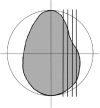




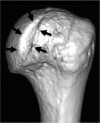
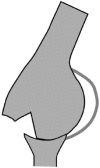
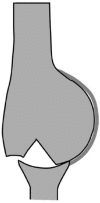




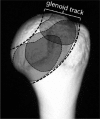

Similar articles
-
Remplissage Versus Modified Latarjet for Off-Track Hill-Sachs Lesions With Subcritical Glenoid Bone Loss.Am J Sports Med. 2018 Jul;46(8):1885-1891. doi: 10.1177/0363546518767850. Epub 2018 Apr 19. Am J Sports Med. 2018. PMID: 29672132
-
The role of bone in glenohumeral stability.EFORT Open Rev. 2018 Dec 20;3(12):632-640. doi: 10.1302/2058-5241.3.180028. eCollection 2018 Dec. EFORT Open Rev. 2018. PMID: 30697443 Free PMC article.
-
The effect of a combined glenoid and Hill-Sachs defect on glenohumeral stability: a biomechanical cadaveric study using 3-dimensional modeling of 142 patients.Am J Sports Med. 2015 Jun;43(6):1422-9. doi: 10.1177/0363546515574677. Epub 2015 Mar 20. Am J Sports Med. 2015. PMID: 25794869
-
Osseous Defects Seen in Patients with Anterior Shoulder Instability.Clin Orthop Surg. 2015 Dec;7(4):425-9. doi: 10.4055/cios.2015.7.4.425. Epub 2015 Nov 13. Clin Orthop Surg. 2015. PMID: 26640623 Free PMC article. Review.
-
Management of off-track Hill-Sachs lesions in anterior glenohumeral instability.J Exp Orthop. 2023 Mar 21;10(1):30. doi: 10.1186/s40634-023-00588-x. J Exp Orthop. 2023. PMID: 36943508 Free PMC article. Review.
Cited by
-
Anterior mid-portion capsular tear with Bankart lesion in recurrent anterior shoulder dislocation: outcome report and bone defect evaluation.Arch Orthop Trauma Surg. 2023 May;143(5):2581-2587. doi: 10.1007/s00402-022-04580-5. Epub 2022 Aug 14. Arch Orthop Trauma Surg. 2023. PMID: 35964261
-
Effects of Glenoid and Humeral Bone Defects on Recurrent Anterior Instability of the Shoulder.Clin Orthop Surg. 2020 Jun;12(2):145-150. doi: 10.4055/cios19060. Epub 2020 May 14. Clin Orthop Surg. 2020. PMID: 32489534 Free PMC article. Review.
-
Do Techniques for Hill-Sachs Remplissage Matter in Terms of Functional and Radiological Outcomes?Orthop J Sports Med. 2021 Jun 28;9(6):23259671211008152. doi: 10.1177/23259671211008152. eCollection 2021 Jun. Orthop J Sports Med. 2021. PMID: 34262976 Free PMC article.
-
Glenoid track and subcritical Hill-Sachs lesion.JSES Int. 2023 Dec 14;8(3):608-613. doi: 10.1016/j.jseint.2023.11.016. eCollection 2024 May. JSES Int. 2023. PMID: 38707566 Free PMC article. Review.
-
Bipolar bone loss and distance to dislocation.Ann Jt. 2024 Jan 5;9:7. doi: 10.21037/aoj-23-17. eCollection 2024. Ann Jt. 2024. PMID: 38529290 Free PMC article. Review.
References
-
- Hertz H. Significance of the limbus glenoidalis for the stability of the shoulder joint. Wien klin Wochenschr Suppl 1984;152:1-23. (In German) - PubMed
-
- Itoi E, Morrey BF, An KN. Biomechanics of the shoulder. In: Matsen FA, Wirth MA, Lippitt SB, Rockwood CA, eds. The shoulder. Fourth ed. Philadelphia: Saunders/Elsevier, 2009:213-265.
-
- Kumar VP, Balasubramaniam P. The role of atmospheric pressure in stabilising the shoulder. An experimental study. J Bone Joint Surg [Br] 1985;67-B:719-721. - PubMed
-
- Itoi E, Motzkin NE, Browne AO, et al. Intraarticular pressure of the shoulder. Arthroscopy 1993;9:406-413. - PubMed
-
- Matsen FA, III, Harryman DT, II, Sidles JA. Mechanics of glenohumeral instability. Clin Sports Medicine 1991;10:783-788. - PubMed
Publication types
LinkOut - more resources
Full Text Sources
Other Literature Sources

